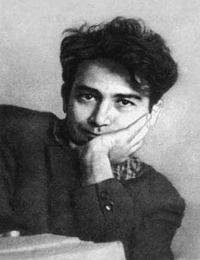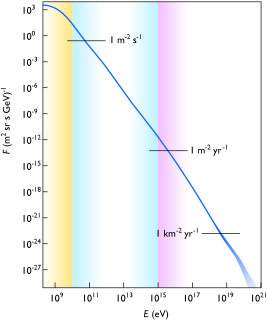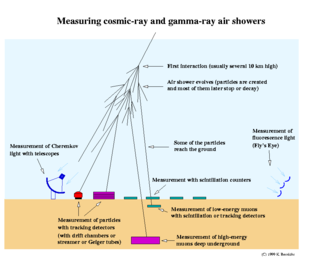Related Research Articles

Neutrino astronomy is the branch of astronomy that observes astronomical objects with neutrino detectors in special observatories. Neutrinos are created as a result of certain types of radioactive decay, nuclear reactions such as those that take place in the Sun or high energy astrophysical phenomena, in nuclear reactors, or when cosmic rays hit atoms in the atmosphere. Neutrinos rarely interact with matter, meaning that it is unlikely for them to scatter along their trajectory, unlike photons. Therefore, neutrinos offer a unique opportunity to observe processes that are inaccessible to optical telescopes, such as reactions in the Sun's core. Neutrinos can also offer a very strong pointing direction compared to charged particle cosmic rays.

The Antarctic Muon And Neutrino Detector Array (AMANDA) is a neutrino telescope located beneath the Amundsen–Scott South Pole Station. In 2005, after nine years of operation, AMANDA officially became part of its successor project, the IceCube Neutrino Observatory.

Neutrino oscillation is a quantum mechanical phenomenon in which a neutrino created with a specific lepton family number can later be measured to have a different lepton family number. The probability of measuring a particular flavor for a neutrino varies between three known states, as it propagates through space.

An air shower is an extensive cascade of ionized particles and electromagnetic radiation produced in the atmosphere when a primary cosmic ray enters the atmosphere. When a particle, which could be a proton, a nucleus, an electron, a photon, or (rarely) a positron, strikes an atom's nucleus in the air it produces many energetic hadrons. The unstable hadrons decay in the air speedily into other particles and electromagnetic radiation, which are part of the particle shower components. The secondary radiation rains down, including x-rays, muons, protons, antiprotons, alpha particles, pions, electrons, positrons, and neutrons.

The IceCube Neutrino Observatory is a neutrino observatory constructed at the Amundsen–Scott South Pole Station in Antarctica. The project is a recognized CERN experiment (RE10). Its thousands of sensors are located under the Antarctic ice, distributed over a cubic kilometre.

The Antarctic Impulsive Transient Antenna (ANITA) experiment has been designed to study ultra-high-energy (UHE) cosmic neutrinos by detecting the radio pulses emitted by their interactions with the Antarctic ice sheet. This is to be accomplished using an array of radio antennas suspended from a helium balloon flying at a height of about 37,000 meters.
The Askaryan radiation also known as Askaryan effect is the phenomenon whereby a particle traveling faster than the phase velocity of light in a dense dielectric produces a shower of secondary charged particles which contains a charge anisotropy and thus emits a cone of coherent radiation in the radio or microwave part of the electromagnetic spectrum. It is similar to the Cherenkov radiation. It is named after Gurgen Askaryan, a Soviet-Armenian physicist who postulated it in 1962.

A neutrino detector is a physics apparatus which is designed to study neutrinos. Because neutrinos only weakly interact with other particles of matter, neutrino detectors must be very large to detect a significant number of neutrinos. Neutrino detectors are often built underground, to isolate the detector from cosmic rays and other background radiation. The field of neutrino astronomy is still very much in its infancy – the only confirmed extraterrestrial sources as of 2018 are the Sun and the supernova 1987A in the nearby Large Magellanic Cloud. Another likely source is the blazar TXS 0506+056 about 3.7 billion light years away. Neutrino observatories will "give astronomers fresh eyes with which to study the universe".
Radio Ice Cherenkov Experiment (RICE) was an experiment designed to detect the Cherenkov emission in the radio regime of the electromagnetic spectrum from the interaction of high energy neutrinos with the Antarctic ice cap. The goals of this experiment are to determine the potential of the radio-detection technique for measuring the high energy cosmic neutrino flux, determining the sources of this flux, and measuring neutrino-nucleon cross sections at energies above those accessible with existing accelerators. Such an experiment also has sensitivity to neutrinos from gamma ray bursts, as well as highly ionizing charged particles traversing the Antarctic icecap.
Astroparticle physics, also called particle astrophysics, is a branch of particle physics that studies elementary particles of astronomical origin and their relation to astrophysics and cosmology. It is a relatively new field of research emerging at the intersection of particle physics, astronomy, astrophysics, detector physics, relativity, solid state physics, and cosmology. Partly motivated by the discovery of neutrino oscillation, the field has undergone rapid development, both theoretically and experimentally, since the early 2000s.

Gurgen Ashotovich Askaryan was a prominent Soviet - Armenian physicist, famous for his discovery of the self-focusing of light, pioneering studies of light-matter interactions, and the discovery and investigation of the interaction of high-energy particles with condensed matter.

Extragalactic cosmic rays are very-high-energy particles that flow into the Solar System from beyond the Milky Way galaxy. While at low energies, the majority of cosmic rays originate within the Galaxy (such as from supernova remnants), at high energies the cosmic ray spectrum is dominated by these extragalactic cosmic rays. The exact energy at which the transition from galactic to extragalactic cosmic rays occurs is not clear, but it is in the range 1017 to 1018 eV.

A cosmic-ray observatory is a scientific installation built to detect high-energy-particles coming from space called cosmic rays. This typically includes photons, electrons, protons, and some heavier nuclei, as well as antimatter particles. About 90% of cosmic rays are protons, 9% are alpha particles, and the remaining ~1% are other particles.
The Neutrino Array Radio Calibration (NARC) experiment was the successor to the Radio Ice Cherenkov Experiment (RICE) which served as a testbed for future development of an eventual large-scale neutrino radio-detection array. NARC involved detecting ultra high energy electron neutrinos through their interactions with ice molecules in the Antarctic icecap, based on the principle of radio coherence. Experimentally, the goal was to detect and measure long-wavelength (radiofrequency) pulses resulting from this interaction. The experiment ended 2012. The experiment is succeeded by the Askaryan Radio Array (ARA) experiment.

NEVOD is a neutrino detector and cosmic ray experiment that attempts to detect Cherenkov radiation arising from interactions between water and charged particles. It represents the first attempt to perform such measurements at the Earth's surface; it is because of this surface deployment that the experiment is also able to investigate cosmic rays. NEVOD is situated at the Moscow Engineering Physics Institute (MEPhI).
Antarctic Ross Ice-Shelf Antenna Neutrino Array (ARIANNA) is a proposed detector for ultra-high energy astrophysical neutrinos. It will detect coherent radio Cherenkov emissions from the particle showers produced by neutrinos with energies above about 10^17 eV. ARIANNA will be built on the Ross Ice Shelf just off the coast of Antarctica, where it will eventually cover about 900 km^2 in surface area. There, the ice-water interface below the shelf reflects radio waves, giving ARIANNA sensitivity to downward going neutrinos and improving its sensitivity to horizontally incident neutrinos. ARIANNA detector stations will each contain 4-8 antennas which search for brief pulses of 50 MHz to 1 GHz radio emission from neutrino interactions.
The Tunka experiment now named TAIGA measures air showers, which are initiated by charged cosmic rays or high energy gamma rays. TAIGA is situated in Siberia in the Tunka valley close to lake Baikal. Meanwhile, TAIGA consists of five different detector systems: Tunka-133, Tunka-Rex, and Tunka-Grande for charged cosmic rays; Tunka-HiSCORE and Tunka-IACT for gamma astronomy. From the measurements of each detector it is possible to reconstruct the arrival direction, energy and type of the cosmic rays, where the accuracy is enhanced by the combination of different detector systems.
The Giant Radio Array for Neutrino Detection (GRAND) is a proposed large-scale detector designed to collect ultra-high energy cosmic particles as cosmic rays, neutrinos and photons with energies exceeding 1017 eV. This project aims at solving the mystery of their origin and the early stages of the universe itself. The proposal, formulated by an international group of researchers, calls for an array of 200,000 receivers to be placed on mountain ranges around the world.
Francis Louis Halzen is a Belgian particle physicist. He is the Hilldale and Gregory Breit Distinguished Professor at the University of Wisconsin-Madison and Director of its Institute for Elementary Particle Physics. Halzen is the Principal Investigator of the IceCube Neutrino Observatory at the Amundsen-Scott South Pole Station in Antarctica, the world's largest neutrino detector which has been operational since 2010.
Abigail Goodhue Vieregg is a professor of physics at the Enrico Fermi Institute and Kavli Institute of Cosmology, University of Chicago, specializing in neutrino astrophysics and cosmology. Her work focuses on cosmic high-energy neutrinos and mapping the cosmic microwave background.
References
- ↑ G.A. Askaryan (1962). "Excess Negative Charge of an Electron-Photon Shower And Its Coherent Radio Emission". Soviet Physics JETP . 14 (2): 441–443.
- ↑ G.A. Askaryan (1965). "Coherent Radio Emission from Cosmic Showers in Air and in Dense Media". Soviet Physics JETP . 21 (3): 658. Bibcode:1965JETP...21..658A.
- ↑ P. Allison; J. Auffenberg; R. Bard; J.J. Beatty; D.Z. Besson; S. Böser; C. Chen; P. Chen; A. Connolly; J. Davies; M. DuVernois; B. Fox; P.W. Gorham; E.W. Grashorn; K. Hanson; J. Haugen; K. Helbing; B. Hill; K.D. Hoffman; E. Hong; M. Huang; M.H.A. Huang; A. Ishihara; A. Karle; D. Kennedy; H. Landsman; T.C. Liu; L. Macchiarulo; K. Mase; T. Meures; R. Meyhandan; C. Miki; R. Morse; M. Newcomb; R.J. Nichol; K. Ratzlaff; M. Richman; L. Ritter; C. Rott; B. Rotter; P. Sandstrom; D. Seckel; J. Touart; G.S. Varner; M.-Z. Wang; C. Weaver; A. Wendorff; S. Yoshida; R. Young (February 2012). "Design and initial performance of the Askaryan Radio Array prototype EeV neutrino detector at the South Pole". Astroparticle Physics. 35 (7): 457. arXiv: 1105.2854 . Bibcode:2012APh....35..457A. doi:10.1016/j.astropartphys.2011.11.010.
- ↑ "ARENA 2018 – Acoustic and Radio EeV Neutrino Detection Activities (12–15 June 2018) · Indico".